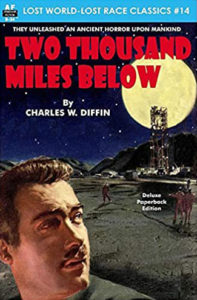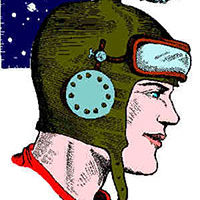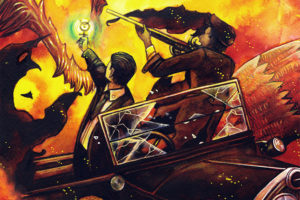 One of Armchair Fiction‘s Lost-World/Lost-Race Classics (#14 to be specific) that I read recently is Two Thousand Miles Below by Charles W. Diffin (1884-1966).
One of Armchair Fiction‘s Lost-World/Lost-Race Classics (#14 to be specific) that I read recently is Two Thousand Miles Below by Charles W. Diffin (1884-1966).
Diffin was an engineer and airplane salesman(?), and had a degree in chemistry, so it’s clear that writing was something he did on the side. He was active only during the 1930s, putting out a few SF novels and short stories in Astounding Stories, but other pulp stories including some Westerns and mysteries. In fact, “Two Thousand Miles Below” was serialized over four issues of Astounding (June, September, and November 1932, and January 1933).
He’s probably best known for the Walter Harkness or “Dark Moon” trilogy of stories, which Armchair Theater has reprinted the first two in one volume. They also put out his novel The Pirate Planet in one of their double volumes.
Two Thousand Miles Below is an interesting hollow-earth novel, and I am always up for one of those. The story kicks off with a prologue set in prehistoric times, where the leader of a band of cavemen named Gor, in a bid to save his tribe, leads them deep underground, only to be sealed in afterwards.
Then the story leaps to modern times where we meet engineer Dean Rawson, who has a plan of using geothermal heat to produce energy in an dead volcano in the California desert. He soon meets a young man named Smithy who quickly becomes his chief assistant. With backing, they setup with men and equipment and get to work. Soon strange things begin happening as they drill down.
Quickly there are strange men with even stranger, deadly weapons who attack them and their equipment. These men are red skinned and have flame weapons and even deadlier disintegration ray guns! In an attempt to fight them off, Dean finds himself underground as a prisoner of these strange beings!
Meanwhile, above ground, Smithy shows there is more to him as he works to help stop an invasion of these strange “mole men” as they are attacking cities in the Southwest, even using their ray guns to destroy planes! The story thus alternates between Rawson underground and Smithy above ground.
Underground, Rawson realizes these mole men aren’t human, though humanoid. There seem to be two related races, one red skinned and in charge, with a yellow-skinned slave race. They have large oval eyes, cone-shaped heads and claw-like hands. They seem prepared to sacrifice Rawson to their fire god when he is saved by normal humans who soon whisk him away in a strange elevator car.
The humans take him further below to where they live in the hollow earth! There is an interior sun, and they live on a large island on an interior ocean. Strangely, they speak English! This is due to an unusual mountain of crystal that has been picking up radio broadcasts from the world above (a station in Los Angeles). His savior is Loah, the daughter of their chief, called Gor, as all are who hold this position. Those cavemen from long ago are their ancestors, and they live in fear of the savage mole men, as they are a peaceful and pastoral people with no weapons.
Rawson, thus, has two tasks. Make sure that Gor and his people are safe from the mole men and also turn the tide of their invasion of the surface world. Will he succeed, when Gor and his people have no weapons? Rawson must use his knowledge of chemistry and science to work out a solution with some of the strange plants and new elements he finds in the hollow earth!
Overall I found this novel interesting, tho flawed. I did like seeing Rawson work out scientific solutions to his problems using what was at hand. I would have liked to have learned more about the history of the mole men, if possible. Originally, I had thought maybe the mole men were some kind of mutant descendants of the cavemen. I haven’t yet read the Dark Moon Saga volume from Armchair Theater, but hope to soon. Check out this one and the rest on their Lost-World/Lost-Race Classics series. (oh, and if you’re wondering were the cover came from, it’s taken from an early paperback cover of The Man Who Sold the Moon.)



